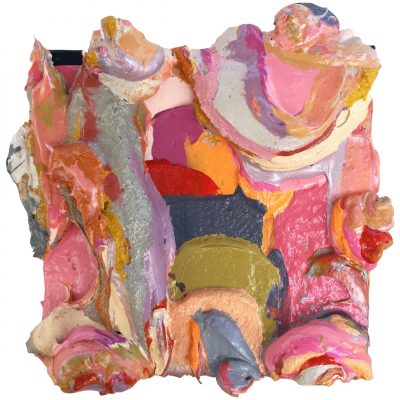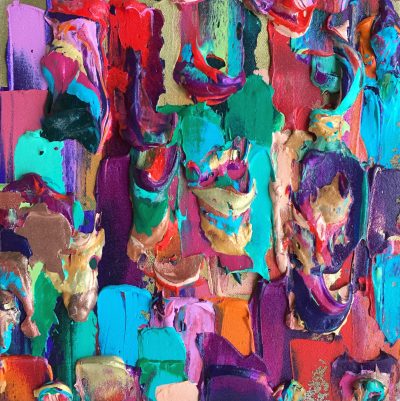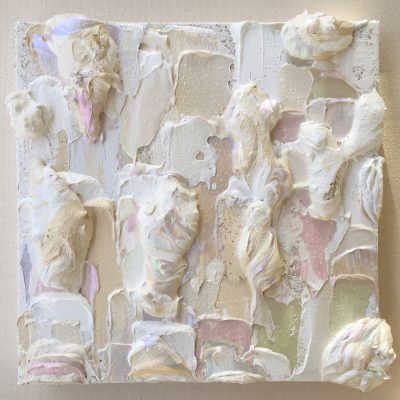Colorful Quest: An Interview with Alison Palizzolo

By Olivia J. Kiers
Alison Palizzolo is a New Hampshire-based painter and the public relations coordinator for the Hood Museum of Art at Dartmouth College. ANE assistant editor Olivia Kiers recently spoke with Palizzolo about her painting practice, getting inspired by museums and nature, and life as an artist in the Granite State.
Art New England: Let’s start at the beginning. You hold degrees in both Art History and Studio Art from Keene State College. Were you always focused on becoming an artist, or working with art in some capacity?
Alison Palizzolo: Both of my parents are artists, so art has always been integrated into my life in one way or another. I took art lessons at the Currier, and my mom gave lessons to me, too. It wasn’t necessarily that, when I was a kid, I thought I was going to be an artist. Still, I’ve always been passionate about and interested in art.
Actually, I was more of a jock growing up, and played basketball pretty much from third grade through my senior year of high school. It was when I got to college that I switched gears to looking closely at art and history.
ANE: How did having both parents as artists affect your perception of the art world? How aware of it were you, growing up?
AP: My mom worked with stained glass. Having hot materials and glass around wasn’t a great idea when I was young, so she stopped practicing… Art was certainly accessible to me through her, but I didn’t have a grasp on “the art world” because she didn’t really participate in it. My step-dad had participated as a ceramic artist—he still does—so I did get little glimpses of it through him. I’ve discovered it more on my own, mostly. My parents always encouraged me to be artistic and to pursue my art, but they never pushed anything on me.
ANE: Many artists relocate to places like New York or LA. Can you talk about your decision to pursue a career in New Hampshire?
AP: I made the decision to pursue an art career in New Hampshire because I have a family—my daughter and my husband—who are settled here. It wouldn’t make much sense for me to move. Also, there is a growing arts community in New Hampshire. You can feel the buzz. It’s incredible, especially in the Upper Valley area around Hanover, which is becoming a little epicenter for arts and artists. There are new galleries opening around the state, and if you are proactive, there are many opportunities. You just have to be driven to find them, more so than in a city.
There’s another reason—I don’t know that city life is for me. I really enjoy living in New Hampshire. The atmosphere and the natural beauty of this state lend themselves to a creative mind. I draw inspiration from my surroundings every day, and I certainly I think my art would be different if I lived somewhere else.

ANE: That’s interesting, because your art is abstract.
AP: Yes, but I draw inspiration from the colors that I see around me on a daily basis. Obviously, color is everywhere you go, and there are lots of different colors in cities as well, but they are saturated, industrialized colors. I truly feel a delight in natural colors—and when I paint, it’s a calming, meditative experience. Having the time to relax, slow down and look closely is important.
ANE: Are you more driven by the process of working with color, or by an envisioned end product inspired by the colors you see?
AP: The art-making process is what drives me, definitely. I love playing with paint and being innovative with my style and with the tools I’m using. I like to mix different mediums with my paint. A lot of it is very experimental to me, though I try not to change too quickly, because that’s not a good thing, either…
Of course, it’s wonderful to see the finished product. But when I’m painting, I’m so focused on the process that when I step back and it’s done, sometimes I’m surprised by the end result. I don’t even remember putting that textural element there. Even though I know I’ve done it, it feels like an unconscious decision driven by the process.
ANE: Does working at a museum influence your creative life, or do you compartmentalize these experiences?
AP: That’s a good question. I love working in the museum because I have the opportunity to be surrounded by art in one way or another, every day… The artwork does not have to be abstract, like mine, and it could be from anywhere. It could be a work from Africa, or Germany. I definitely use my closeness to museums to my advantage, yet at the same time, part of the process is seeing what’s been done and trying to do something different. I think every artist wants to be different. They want to have an edge—a voice of their own.

ANE: Do you have a favorite period of art history that you approach often?
AP: I love 19th- and 20th-century art, and I also really like the Renaissance. Who doesn’t? Of course, there’s something about abstract art that speaks to me. There’s Josef Albers, who made non-representational work and I totally appreciate him. Representational work is something that doesn’t come naturally to me, so in a way I can appreciate it more.
ANE: How do you find balance between your creative, professional and personal lives? What are some of the challenges you face?
AP: I don’t sleep much! But that’s okay, because I love it. My work is immediate and it’s done in one sitting, which helps. I’ll mix colors for the first three to five hours of sitting there, then I will apply the paint to the canvas for the next two to three hours, depending on the size of the canvas. I do a lot at night after I put my daughter to bed. To be honest, I haven’t consciously made a schedule; I’ve just found time to make it all work.
I really want to enjoy painting. Once something stops being fun—once you stop feeling passionate about something—then it becomes just a job. Scheduling can become a factor, for me at least, in taking away the fun. My painting needs to be natural. I don’t want to force it.
ANE: What’s next on the horizon for you?
AP: I will have a big exhibition at Howe Library’s Ledyard Gallery in Hanover next year, and I [will be] an artist in residence at the Inaugural Arts Week at Canterbury Shaker Village (July 17–21, 2018).
You know, sometimes, doing the administrative work is more difficult than doing the paintings. There’s a lot of admin work that goes into being an artist now. I’m constantly applying to juried shows and residencies, trying to get my name and resume out there. I’m always working towards then next thing—there’s no stopping.
Images
1. Limitless, 2017, acrylics mixed with ceramic stucco, heavy gloss, and iridescent medium on canvas, 5 x 5″. All images are courtesy the artist.
2. Summer’s Sendoff, 2017, acrylics mixed with ceramic stucco and iridescent medium on canvas, 12 x 12″.
3. Interference, 2017, acrylics mixed with ceramic stucco and iridescent medium on canvas, 12 x 12″.
See more works by Alison Palizzolo on her website: artbyapalizzolo.com.
